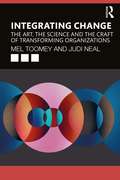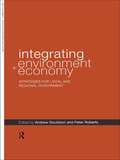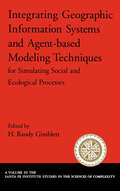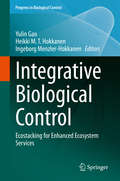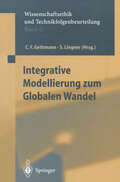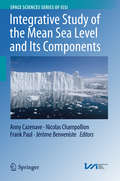- Table View
- List View
Integrating Change: The Art, the Science and the Craft of Transforming Organizations
by Mel Toomey Judi NealChange processes in organizations are time consuming, expensive, and often don’t create the intended results. This book creates a new way for leaders to relate to change from a place of deeper understanding. Based on years of research, consulting, and teaching, the models and frameworks described in this book have been applied successfully in organizations such as Johnson & Johnson, AT&T, IBM, Facebook, Charles Schwab & Company, and Accenture. The book provides breakthrough thinking to leaders who find themselves in the chaos of multiple, high amplitude changes that cannot be managed from an autocratic or even a participative mindset. The successful transformation of a human system does not require that people change who they are so much as it requires they become more of who they are—more like themselves. Change does not require new step-by-step models offered by an outside expert. It requires teaching people how to become model builders. As a result of this deeper transformation of mindset, not only will people in the organization be able to manage the particular change crisis facing them in the moment, they will develop a new relationship to change so that strategic thinking and breakthrough business outcomes become part of the organizational norm. This book will primarily appeal to experienced leaders, senior managers, and change agents who have learned that the textbook recipes for initiating or responding to change don’t work. It is also useful supplementary reading for students of organizational studies and leadership.
Integrating Data Science and Earth Science: Challenges and Solutions (SpringerBriefs in Earth System Sciences)
by Laurens M. Bouwer Doris Dransch Roland Ruhnke Diana Rechid Stephan Frickenhaus Jens GreinertThis open access book presents the results of three years collaboration between earth scientists and data scientist, in developing and applying data science methods for scientific discovery. The book will be highly beneficial for other researchers at senior and graduate level, interested in applying visual data exploration, computational approaches and scientifc workflows.
Integrating Disaster Science and Management: Global Case Studies in Mitigation and Recovery
by Pijush Samui Dookie Kim Chandan GhoshIntegrated Disaster Science and Management: Global Case Studies in Mitigation and Recovery bridges the gap between scientific research on natural disasters and the practice of disaster management. It examines natural hazards, including earthquakes, landslides and tsunamis, and uses integrated disaster management techniques, quantitative methods and big data analytics to create early warning models to mitigate impacts of these hazards and reduce the risk of disaster. It also looks at mitigation as part of the recovery process after a disaster, as in the case of the Nepal earthquake. Edited by global experts in disaster management and engineering, the book offers case studies that focus on the critical phases of disaster management. - Identifies advanced techniques and models based on natural disaster science for forecasting disasters and analyzing risk - Offers a holistic approach to the problem of disaster management, including preparation, recovery, and resilience - Includes coverage of social, economic, and environmental impacts on disasters
Integrating Emergency Management and Disaster Behavioral Health: One Picture through Two Lenses
by Brian W. Flynn Ronald ShermanIntegrating Emergency Management and Disaster Behavioral Health identifies the most critical areas of integration between the profession of emergency management and the specialty of disaster behavioral health, providing perspectives from both of these critical areas, and also including very practical advice and examples on how to address key topics. Each chapter features primary text written by a subject matter expert from a related field that is accompanied by a comment by another profession that is then illustrated with a case study of, or a suggested method for, collaboration. - Addresses the current state of the collaboration between the emergency management and disaster behavioral health communities as presented from pioneers in their respective fields - Focuses on practical examples of what works and what doesn't - Stresses both legal and ethical considerations and the public-private partnerships that are important for leadership in disaster situations - Covers Emergency Operations Centers (EOCs) and risk communication
Integrating Environment and Economy: Strategies for Local and Regional Government
by Andrew Gouldson Peter RobertsIntegrating Environment and Economy provides a detailed and accessible examination of how integrated approaches enable economic and social activities to support environmental objectives. This is a key text for the many taught Masters courses covering the issues of environmental management and economic development Features of the book:* covers strong areas of undergraduate and postgraduate study* detailed practice-based case studies at both local and regional levels* up-to-date theory using real-life examples
Integrating Environment and Economy: Strategies for Local and Regional Government
by Andrew Gouldson Peter RobertsIntegrating Environment and Economy provides a detailed and accessible examination of how integrated approaches enable economic and social activities to support environmental objectives. This is a key text for the many taught Masters courses covering the issues of environmental management and economic development Features of the book:* covers strong areas of undergraduate and postgraduate study* detailed practice-based case studies at both local and regional levels* up-to-date theory using real-life examples
Integrating Geographic Information Systems And Agent-based Modeling Techniques For Simulating Social And Ecological Processes
by H. Randy GimblettIntegrating Information in Built Environments (Cib Ser.)
by Adriana X. Sanchez Keith D. Hampson Geoffrey LondonIn an increasingly globalised built environment industry, achieving higher levels of integration across organisational and software boundaries can lead to improved economic, social and environmental outcomes. This book is the direct result of a collaborative global network of industry and academic researchers spread across nine countries as part of CIB’s (International Council for Research and Innovation in Building and Construction) Task Group 90 (TG90) Information Integration in Construction (IICON). The book provides a broad view of some of the opportunities and challenges brought by integrating information across organisational and system boundaries in the built environment industry. Chapters cover a large range of topics and are separated into three sections: resources, processes and added value. They provide a much-needed international perspective on a current global evolution in the industry and present leading original research and valuable lessons for researchers, industry practitioners, government clients and policy makers across the industry. Key features include: a broad range of topics that are not covered elsewhere in the literature; contributions from a diverse group of industry research leaders from across the globe; exemplar case studies providing real-world examples of where information integration has been a key factor for success or lack thereof has been at the root cause of failure; an analysis of future priority areas for research and development investment as well as their strategic implications for public and private decision-makers; the book will deliver innovation in best practice methodology for information sharing across disciplines and between the design, construction and asset management sectors.
Integrating Information in Built Environments (Cib Ser.)
by Adriana X. Sanchez Keith Hampson Geoffrey LondonIn an increasingly globalised built environment industry, achieving higher levels of integration across organisational and software boundaries can lead to improved economic, social and environmental outcomes. This book is the direct result of a collaborative global network of industry and academic researchers spread across nine countries as part of CIB’s (International Council for Research and Innovation in Building and Construction) Task Group 90 (TG90) Information Integration in Construction (IICON). The book provides a broad view of some of the opportunities and challenges brought by integrating information across organisational and system boundaries in the built environment industry. Chapters cover a large range of topics and are separated into three sections: resources, processes and added value. They provide a much-needed international perspective on a current global evolution in the industry and present leading original research and valuable lessons for researchers, industry practitioners, government clients and policy makers across the industry. Key features include: a broad range of topics that are not covered elsewhere in the literature; contributions from a diverse group of industry research leaders from across the globe; exemplar case studies providing real-world examples of where information integration has been a key factor for success or lack thereof has been at the root cause of failure; an analysis of future priority areas for research and development investment as well as their strategic implications for public and private decision-makers; the book will deliver innovation in best practice methodology for information sharing across disciplines and between the design, construction and asset management sectors.
Integrating Seaports and Trade Corridors
by Robert J. McCalla Brian SlackSeaport gateways and the corridors which connect them to widely dispersed hinterlands are of vital and essential importance to international trade and the world economy. Distributing goods to ultimate land destinations or bringing the goods to seaports from inland origins is organizationally complex involving multiple actors. This book furthers understanding about how this movement is organized, the role of ports acting as gateways and the actions of corridor players. A key question that confronts the shipping and port industries, as well as public authorities, is how to increase the benefits of maritime trade to the companies and institutions directly involved as well as the port city-regions where the transfers take place? This question is being posed in the midst of a global economic recession and trade downturn, and in the context of contemporary policy frameworks whose goals are to generate economic benefits and efficiencies rather than to maximize traffic volumes. This book puts into perspective the reality, opportunities and challenges facing seaport gateways and corridors now and in the future.
Integrating Seaports and Trade Corridors
by Robert J. McCalla Brian SlackSeaport gateways and the corridors which connect them to widely dispersed hinterlands are of vital and essential importance to international trade and the world economy. Distributing goods to ultimate land destinations or bringing the goods to seaports from inland origins is organizationally complex involving multiple actors. This book furthers understanding about how this movement is organized, the role of ports acting as gateways and the actions of corridor players. A key question that confronts the shipping and port industries, as well as public authorities, is how to increase the benefits of maritime trade to the companies and institutions directly involved as well as the port city-regions where the transfers take place? This question is being posed in the midst of a global economic recession and trade downturn, and in the context of contemporary policy frameworks whose goals are to generate economic benefits and efficiencies rather than to maximize traffic volumes. This book puts into perspective the reality, opportunities and challenges facing seaport gateways and corridors now and in the future.
Integrating Sustainable Development in International Investment Law: Normative Incompatibility, System Integration and Governance Implications (ISSN)
by Manjiao ChiThe current international investment law system is insufficiently compatible with sustainable development. To better address sustainable development concerns associated with transnational investment activities, international investment agreements should be made more compatible with sustainable development.Integrating Sustainable Development in International Investment Lawpresents an important systematic study of the issue of sustainable development in the international investment law system, using conceptual, normative and governance perspectives to explore the challenges and possible solutions for making international investment law more compatible with sustainable development. Chi suggests that to effectively address the sustainable development concerns associated with transnational investment activities, the international investment agreements system should be reformed. Such reform should feature redesigning the provisions of the agreements, improving the structure of international investment agreements, strengthening the function of soft law, engaging non-state actors and enhancing the dispute settlement mechanism.The book is primarily aimed at national and international treaty and policy-makers, lawyers and scholars. It is also suitable for graduate students studying international law and policy-making.The Open Access version of this book, available at http://www.taylorfrancis.com, has been made available under a Creative Commons Attribution-Non Commercial-No Derivatives (CC-BY) 4.0 license.
Integrating Sustainable Development in International Investment Law: Normative Incompatibility, System Integration and Governance Implications (ISSN)
by Manjiao ChiThe current international investment law system is insufficiently compatible with sustainable development. To better address sustainable development concerns associated with transnational investment activities, international investment agreements should be made more compatible with sustainable development.Integrating Sustainable Development in International Investment Lawpresents an important systematic study of the issue of sustainable development in the international investment law system, using conceptual, normative and governance perspectives to explore the challenges and possible solutions for making international investment law more compatible with sustainable development. Chi suggests that to effectively address the sustainable development concerns associated with transnational investment activities, the international investment agreements system should be reformed. Such reform should feature redesigning the provisions of the agreements, improving the structure of international investment agreements, strengthening the function of soft law, engaging non-state actors and enhancing the dispute settlement mechanism.The book is primarily aimed at national and international treaty and policy-makers, lawyers and scholars. It is also suitable for graduate students studying international law and policy-making.The Open Access version of this book, available at http://www.taylorfrancis.com, has been made available under a Creative Commons Attribution-Non Commercial-No Derivatives (CC-BY) 4.0 license.
Integrating Sustainable Development into the Curriculum (Innovations in Higher Education Teaching and Learning #18)
by Enakshi Sengupta Patrick Blessinger Taisir YaminCreating a sustainable future is one of the biggest challenges that we face as a human race. This is often made even harder by the apathy of many towards the need for sustainability. Education will play a crucial role in finding a solution to the global climate crisis, by shaping future generations who are informed, enlightened and ready to take action. This book explores the value of institutions of higher education in leading the way on the topic of sustainability education by ensuring that it is well entrenched in the curriculum, as well as in everyday practice and lifestyles. This unique volume features authors from different parts of the world who narrate their own experience of integrating sustainability into their curriculum, and teaching sustainability to students. By exploring the idea that education and sustainability should be seen as intrinsically linked if we are to see global change, this important text will prove invaluable for leaders, scholars and policy specialists in higher education.
Integrating Sustainable Development into the Curriculum (Innovations in Higher Education Teaching and Learning #18)
by Enakshi Sengupta Patrick Blessinger Taisir YaminCreating a sustainable future is one of the biggest challenges that we face as a human race. This is often made even harder by the apathy of many towards the need for sustainability. Education will play a crucial role in finding a solution to the global climate crisis, by shaping future generations who are informed, enlightened and ready to take action. This book explores the value of institutions of higher education in leading the way on the topic of sustainability education by ensuring that it is well entrenched in the curriculum, as well as in everyday practice and lifestyles. This unique volume features authors from different parts of the world who narrate their own experience of integrating sustainability into their curriculum, and teaching sustainability to students. By exploring the idea that education and sustainability should be seen as intrinsically linked if we are to see global change, this important text will prove invaluable for leaders, scholars and policy specialists in higher education.
Integration and Clustering for Sustainable Economic Growth (Contributions to Economics)
by Elena G. Popkova Valentina E. Sukhova Aleksey F. Rogachev Yulia G. Tyurina Olga A. Boris Valentina N. ParakhinaThis book describes the importance of integration and clustering in creating sustainable economic growth. Modern economic conditions demonstrate the need for governmental stimulation of cluster initiatives in entrepreneurship, and make it necessary to study the experience of developed countries in the sphere of stimulation of cluster initiatives in entrepreneurship, and to offer recommendations for improving the system of state stimulation of these initiatives. The authors conclude that at present, innovational economy is an economic system that functions on the basis of business networks, as this model offers innovational cooperation between specialists from various scientific and technical spheres, between organizations of various sizes (large, medium, and small), and between groups of various types of companies. Cluster strategy in modern global practice is one of the most important tools of public policy for increasing the competitiveness of national economies. This means that the most competitive spheres develop on the basis of the cluster principle, and support for cluster building increases a country’s economic competitiveness.
Integration of Earth Science Research on the Turkish and Greek 1999 Earthquakes (NATO Science Series: IV: #9)
by Naci Görür, Gerassimos A. Papadopoulos and Nilgün OkayIn 1999, two earthquakes occurred in the Istanbul-Marmara region of Turkey and the Athens-Corinth region of Greece, and an increased risk of further events caused great concern among the earth science community. This book presents and discusses the latest results from studies of the Izmit-Düzce and Athens earthquakes and assesses the data that are available and relevant to the geology, seismology, tectonics, geodesy and other fields related to earthquake studies and to evaluate earthquake hazard potential.
Integration of GIS and Remote Sensing (Mastering GIS: Technol, Applications & Mgmnt #19)
by Victor MesevIn an age of unprecedented proliferation of data from disparate sources the urgency is to create efficient methodologies that can optimise data combinations and at the same time solve increasingly complex application problems. Integration of GIS and Remote Sensing explores the tremendous potential that lies along the interface between GIS and remote sensing for activating interoperable databases and instigating information interchange. It concentrates on the rigorous and meticulous aspects of analytical data matching and thematic compatibility - the true roots of all branches of GIS/remote sensing applications. However closer harmonization is tempered by numerous technical and institutional issues, including scale incompatibility, measurement disparities, and the inescapable notion that data from GIS and remote sensing essentially represent diametrically opposing conceptual views of reality. The first part of the book defines and characterises GIS and remote sensing and presents the reader with an awareness of the many scale, taxonomical and analytical problems when attempting integration. The second part of the book moves on to demonstrate the benefits and costs of integration across a number of human and environmental applications. This book is an invaluable reference for students and professionals dealing not only with GIS and remote sensing, but also computer science, civil engineering, environmental science and urban planning within the academic, governmental and commercial/business sectors.
Integration of Information for Environmental Security: Environmental Security - Information Security - Disaster Forecast and Prevention - Water Resources Management (NATO Science for Peace and Security Series C: Environmental Security)
by H. Gonca Coskun H. Kerem Cigizoglu M. Derya MaktavWater management and disasters, including droughts and floods are becoming very important subjects in the international platforms. This book will provide information about high technology techniques to solve important problems using remote sensing and GIS for topics such as the environmental security, water resources management, disaster forecast and prevention and information security.
Integration of Legume Crops with Cereal Crops Under Changing Climate: Sustainably Increasing Food Production
by Samiha Ouda Abd El-Hafeez ZohryThe world population is steadily increases with high rate in the past decade from 7,126 billion inhibitors in 2012 to 8,095 billion inhibitors in 2024, with 14% increase. In the meantime, the number of severely food insecure people were 604.5 million in 2014, which increased by 53% in 2020 to reach 927.6 million people. These numbers raise large concerns about the future of food production to feed these continually growing population. Lately, many developing countries rely on importing large quantities of crops, such as wheat, maize, and rice to meet their food and feed needs. The negative impact of climate change and its consequences, namely high temperature causing low crops productivity and water scarcity, which causing great disruptions in food production systems. Therefore, increasing the production of cereal crops worldwide can be achieved through increasing average yield per unit area or expanding the area devoted to cereals into more marginal lands. Moreover, breeding for more resilient cultivars, which can release its potential yield could play an important role in increasing total production under the adverse growth conditions. Inclusion of legume crops, such as soybean, peanut, and cowpea in cereal-based cropping systems is a viable strategy to increase production of cereal crops. It also helps in reducing the use of chemical fertilizer. It has been reported that intercropping legume crops with cereal crops can increase the productivity of both crops. Additionally, an increase in soil nitrogen, phosphorus and potassium has been also reported when legume crops were included in cereal-based cropping system. It has been also reported that inclusion of legume crops increases the soil water-holding capacity and water used efficiency. Thus, inclusion of legume crops in cereal-based cropping systems can increase its productivity, as well as attains the sustainable use of soil and water resources. In this book, we will thoroughly tackle the benefits of the integration of legume crops within cereal-based cropping system, namely wheat, maize and rice (paddy and upland) under the changing climate (current and future). We also reviewed the innovations and interventions that could sustainably intensify the production of cereals to reduce hunger and poverty. We will use both modeling and simulation approaches to assess the impact of climate change using CMIP6 mean projection of two future scenarios, namely SSP1-2.6 and SSP5-8.5 in two time-intervals (2060-2079 and 2080-2099) on the yield and water requirements of wheat, maize and rice (paddy and upland).
Integration on Infinite-Dimensional Surfaces and Its Applications (Mathematics and Its Applications #496)
by A. UglanovIt seems hard to believe, but mathematicians were not interested in integration problems on infinite-dimensional nonlinear structures up to 70s of our century. At least the author is not aware of any publication concerning this theme, although as early as 1967 L. Gross mentioned that the analysis on infinite dimensional manifolds is a field of research with rather rich opportunities in his classical work [2. This prediction was brilliantly confirmed afterwards, but we shall return to this later on. In those days the integration theory in infinite dimensional linear spaces was essentially developed in the heuristic works of RP. Feynman [1], I. M. Gelfand, A. M. Yaglom [1]). The articles of J. Eells [1], J. Eells and K. D. Elworthy [1], H. -H. Kuo [1], V. Goodman [1], where the contraction of a Gaussian measure on a hypersurface, in particular, was built and the divergence theorem (the Gauss-Ostrogradskii formula) was proved, appeared only in the beginning of the 70s. In this case a Gaussian specificity was essential and it was even pointed out in a later monograph of H. -H. Kuo [3] that the surface measure for the non-Gaussian case construction problem is not simple and has not yet been solved. A. V. Skorokhod [1] and the author [6,10] offered different approaches to such a construction. Some other approaches were offered later by Yu. L. Daletskii and B. D. Maryanin [1], O. G. Smolyanov [6], N. V.
Integrative Approach to Comprehensive Building Renovations (Green Energy and Technology)
by Vesna Žegarac Leskovar Miroslav PremrovThis book presents a new approach to building renovation, combining aspects of various professional disciplines, integrating green building design, structural stability, and energy efficiency. It draws attention to several often-overlooked qualities of buildings that should be comprehensively integrated into the context of building renovation.The book presents an overview of the most important renovation approaches according to their scope, intensity, and priorities. Combining basic theoretical knowledge and the authors’ scientific research it emphasizes the importance of simultaneous consideration of energy efficiency and structural stability in building renovation processes. It simultaneously analyses the effects of various renovation steps related to the required level of energy efficiency, while it also proposes the options of building extension with timber-glass upgrade modules as the solution to a shortage of usable floor areas occurring in large cities.This book offers building designers and decision makers a tool for predicting energy savings in building renovation processes and provides useful guidelines for architects, city developers and students studying architecture and civil engineering. Additionally, it demonstrates how specific innovations, e.g., building extensions with timber-glass modules, can assist building industry companies in the planning and development of their future production.The main aim of the current book is to expose various approaches to the renovation of existing buildings and to combine practical experience with existing research, in order to disseminate knowledge and raise awareness on the importance of integrative and interdisciplinary solutions.
Integrative Biological Control: Ecostacking for Enhanced Ecosystem Services (Progress in Biological Control #20)
by Yulin Gao Heikki M. T. Hokkanen Ingeborg Menzler-HokkanenThis book is the first to integrate biological control into a conceptual framework – ecostacking - uniting all aspects of biological control and ecosystem services. In 2018 the "First International Congress of Biological Control" was organised and held in Beijing, China. The chapters highlight some of the achievements presented at the congress, worldwide. Of particular significance are the numerous contributions by Chinese researchers illustrating the remarkable progress made on developing and adopting multiple biological control strategies over vast agricultural areas, largely replacing chemical pesticides for sustainable agricultural and horticultural production. In many parts of the world including Europe, fragmented research based on short-term funding has been unable to answer to the needs to develop sustainable long-term solutions to crop protection, while colleagues in China have been successful in implementing programs that exemplify the power of the ecostacking approach. Key contributions by European and US specialists combined with the expertise and experiences by the Chinese contributors comprise the building blocks for the integration of biological control approaches into the overall frame of ecostacking. This book will lead the way to a broader, integrated adoption of biological control techniques in sustainable pest, disease and weed management supporting also the functioning of other key ecosystem services.Chapter 2 of this book isavailable openaccess under a CC BY 4.0 license at link.springer.com
Integrative Modellierung zum Globalen Wandel (Ethics of Science and Technology Assessment #17)
by Sevim KiliçDie vorliegende Publikation thematisiert aktuelle Probleme integrativer Modellierung vor dem Hintergrund des Ziels der Forschung zum globalen Wandel. Dabei werden insbesondere Fragen der Modellbildung und Szenarienentwicklung wie auch die Beurteilung ihrer qualitätssichernden Kriterien erörtert. Das Ziel ist eine umfassende Analyse von Chancen und Limitationen integrativer Forschungs- und Modellierungsarbeit, die im Rahmen der Global Change-Forschung geleistet wird. Durch Einbringung von Erfahrungen aus der Forschungspraxis, ihrer theoretischen Fundierung und methodischen Reflexion soll dieses Ziel erreicht werden. Die resultierenden Erkenntnisse sollen der Standortbestimmung und dem Fortschritt integrativer Forschung zum globalen Wandel dienen - auf strategischer Ebene auch der Gewinnung von Perspektiven für die weitere Entwicklung und Schwerpunktsetzung in Deutschland.
Integrative Study of the Mean Sea Level and Its Components (Space Sciences Series of ISSI #58)
by Anny Cazenave Nicolas Champollion Frank Paul Jérôme BenvenisteThis volume presents the most recent results of global mean sea level variations over the satellite altimetry era (starting in the early 1990s) and associated contributions, such as glaciers and ice sheets mass loss, ocean thermal expansion, and land water storage changes. Sea level is one of the best indicators of global climate changes as it integrates the response of several components of the climate system to external forcing factors (including anthropogenic forcing) and internal climate variability. Providing long, accurate records of the sea level at global and regional scales and of the various components causing sea level changes is of crucial importance to improve our understanding of climate processes at work and to validate the climate models used for future projections. The Climate Change Initiative project of the European Space Agency has provided a first attempt to produce consistent and continuous space-based records for several climate parameters observable from space, among them sea level. This book presents current knowledge of the sea level budget over the altimetry era and 20th century.Previously published in Surveys in Geophysics, Volume 38, Issue 1, 2017
